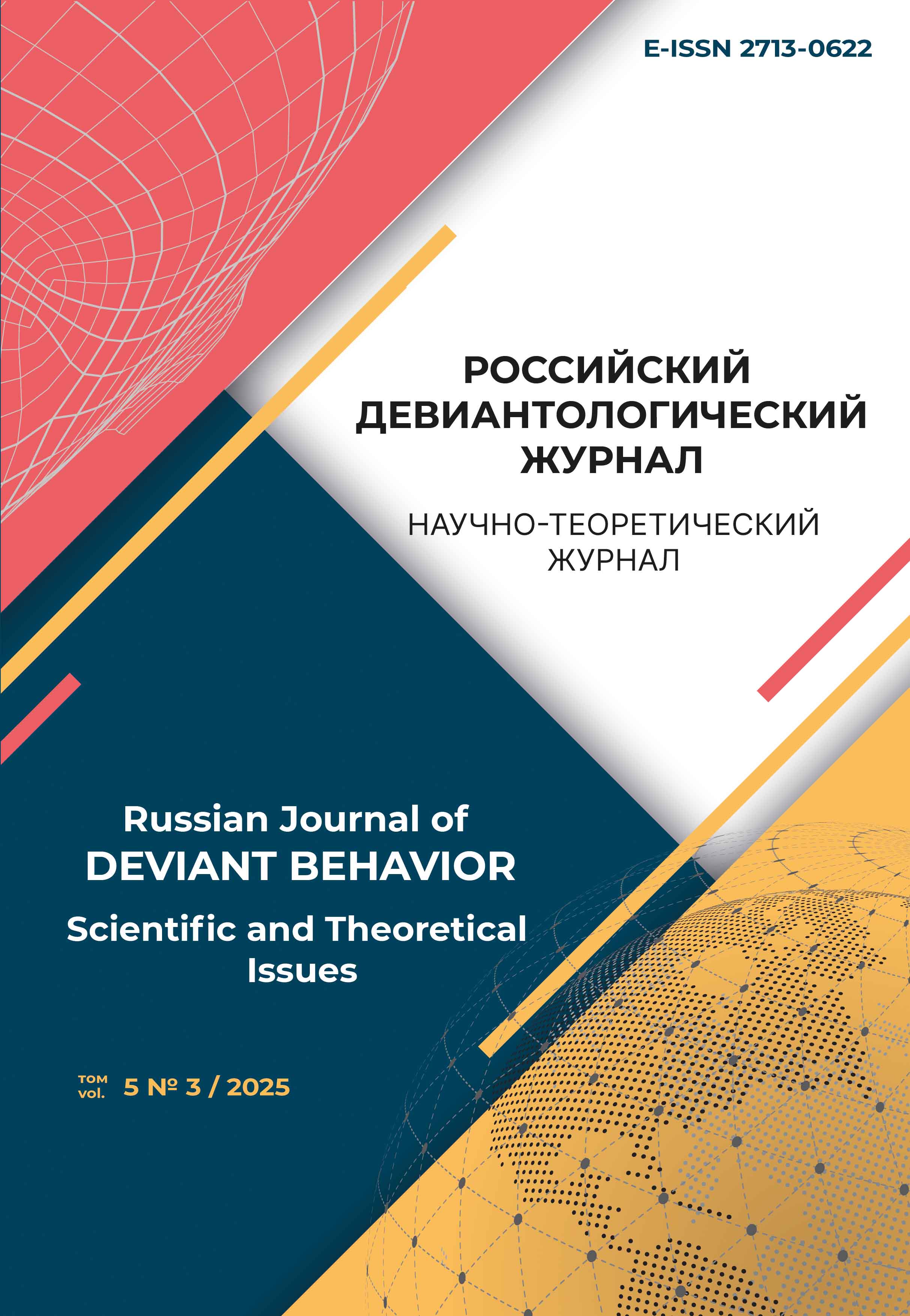from 01.01.2011 to 01.01.2025
Saint Petersburg, St. Petersburg, Russian Federation
UDC 343.9.01
Introduction. The article deals with classical and contemporary criminological theories considered to be still relevant, as well as their influence on solving problems of crime prevention and ensuring security in society. However, while classical criminological theories mainly focused on explaining the causes of criminal behavior, contemporary theories, such as theories of development and life cycle, spatial distribution of crime, etc., are based on interdisciplinary research taking into account present-day social contexts and their related security issues. Research methods. The research is based on general scientific methods, such as comparison, analysis, synthesis, as well as deductive methods, making it possible to formulate some general conclusions. Conclusion. Over many decades, the study of crime and its causes has significantly evolved, extending beyond criminal law and the examination of factors contributing to criminal behavior. The research findings reveal that a synergistic approach, integrating ideas of both traditional and contemporary criminological theories, is crucial for developing effective security measures in a fast changing world. Interdisciplinary interaction with other sciences is becoming the cornerstone of contemporary criminology, being essential for developing effective programmes for providing the state and community safety.
safety, deviant behavior, classical theories, criminology, interdisciplinarity, crime, modern technologies
1. Alferova, E. V. (2023). Nejropravo: dostizheniya v oblasti nejronauki i ih primenenie v kriminologii, kriminalistike i pravosudii. Social'nye i gumanitarnye nauki. Otechestvennaya i zarubezhnaya literatura. Ser. 4: Gosudarstvo i pravo, 2, 206–216.
2. Gilinskij, Ya. I. (2009). Kriminologiya. Teoriya, istoriya, empiricheskaya baza, social'nyj kontrol': mono¬grafiya. Saint Petersburg: Izdatel'stvo «Yuridicheskij centr Press».
3. Gottfredson, M. R., Hirshi, T. (2014). Obshchaya teoriya prestupnosti. Glava 1. Klassicheskaya teoriya i ponyatie prestupleniya. V E. L. Paneyah, A. M. Kadnikova (red.), Pravo i pravoprimenenie v zerkale social'nyh nauk: hrestomatiya sovremennyh tekstov (str. 283–294). Moskow: Statut.
4. Karpov, V. O. (2017). Kriminologicheskij analiz sovremennogo profilirovaniya i ego napravlenij. Vestnik Kazanskogo yuridicheskogo instituta MVD Rossii, 1 (127), 94–97.
5. Lombrozo, Ch. (2005). Prestupnyj chelovek: monografiya (per. s ital.). Moskow: Eksmo.
6. Merton, R. (2006). Social'naya teoriya i social'naya struktura (per. s angl. E. N. Egorovoj i dr.). Moskow: AST; Hranitel'.
7. Nikolaev, V. G. (2003). Chikagskaya shkola sociologii o prestupnosti (vstupitel'naya stat'ya V. G. Niko¬laeva). Lichnost'. Kul'tura. Obshchestvo, 5 (3-4 (17-18)), 189–196.
8. Razogreeva, A. M. (2017). Preduprezhdenie prestuplenij pri pomoshchi sredovogo proektirovaniya: zashchishchayushchee prostranstvo i zashchishchennoe prostranstvo. Vserossijskij kriminolo-gicheskij zhurnal, 11 (4), 706–716.
9. Rastorguev, S. V. (2018). Ekstremizm v molodezhnoj srede sovremennoj Rossii: vidy, faktory raspros¬traneniya, myagkie tekhnologii. Politicheskaya nauka, 4, 124–145. https://doi.org/10.31249/ poln/2018.04.07
10. Agnew, R. (1992). Foundation for a general strain theory of crime and delinquency. Criminology, 30 (1), 47–87. https://doi.org/10.1111/j.1745-9125.1992.tb01093.x
11. Angwin, J., Larson, J., Mattu, S., & Kirchner, L. (2022). Machine bias. In K. Martin (Ed.), Ethics of Data and Analytics (pp. 254–264). New York: Auerbach Publications.
12. Bedoya, A., & Portnoy, J. (2022). Biosocial Criminology: History, Theory, Research Evidence, and Policy. Victims & Offenders, 18 (8), 1599–1629. https://doi.org/10.1080/15564886.2022.2133035
13. Carley, K. (2020). Social Cybersecurity: An Emerging Science. Computational and Mathematical Organizational Theory, 26 (4), 365–381.
14. Dressel, J., & Farid, H. (2018). The Accuracy, Fairness, and Limits of Predicting Recidivism. Science Advances, 4 (1). https://doi.org/10.1126/sciadv.aao5580
15. Farmer, J. F. (2018). Polemics on the Etiology of Juvenile Delinquency: A Review of Some Multi-ple-Perspective Attacks on Travis Hirschi’s Social Bonding Theory. Issues in Social Science, 6 (2), 69–89. https://doi.org/10.5296/iss.v6i2.13746
16. Farrington, D. P., Kazemian, L., & Piquero, A. R. (Eds.) (2018). The oxford handbook of develop-mental and life-course criminology. Oxford University Press, USA. https://doi.org/10.1093/ oxfordhb/9780190201371.001.0001
17. Grubb, J., & Posick, Ch. (2018). Applying Agnew’s Integrated Theory of Crime and Delinquency to Victimization Risk: A Contemporaneous and Longitudinal Examination. Criminal Justice Review, 43 (3), 289–308. https://doi.org/10.1177/0734016818756487
18. Jaishankar, K. (2007). Cyber Criminology: Evolving a novel discipline with a new journal. Interna-tional Journal of Cyber Criminology. 1 (1), 1–6. https://doi.org/10.5281/zenodo.18276.
19. Laub, J. H., & Sampson, R. J. (2020). Life-Course and Developmental Criminology: Looking Back, Moving Forward—ASC Division of Developmental and Life-Course Criminology Inaugu-ral David P. Farrington Lecture, 2017. Journal of Developmental and Life-Course Criminology, 6 (2), 158–171. https://doi.org/10.1007/s40865-019-00110-x
20. Lu, W., Lee, G., & Williams, I. (2019). The Spatial and Social Patterning of Property and Violent Crime in Toronto Neighborhoods: A Spatial-Quantitative Approach. ISPRS International Journal of Geo-Information, 8 (1), 51. https://doi.org/10.3390/ijgi8010051
21. Skoczylis, J., & Andrews, S. (2022). Strain theory, resilience, and far-right extremism: the impact of gender, life experiences and the internet. Critical Studies on Terrorism, 15 (1), 143–168. https://doi.org/10.1080/17539153.2022.2031137
22. Yildiz Durak, Y., & Saritepeci, M. (2020). Examination of the Relationship between Cyberbullying and Cyber Victimization. Journal of Child and Family Studies, 29 (10), 2905–2915. https:// doi.org/10.1007/s10826-020-01768-4














